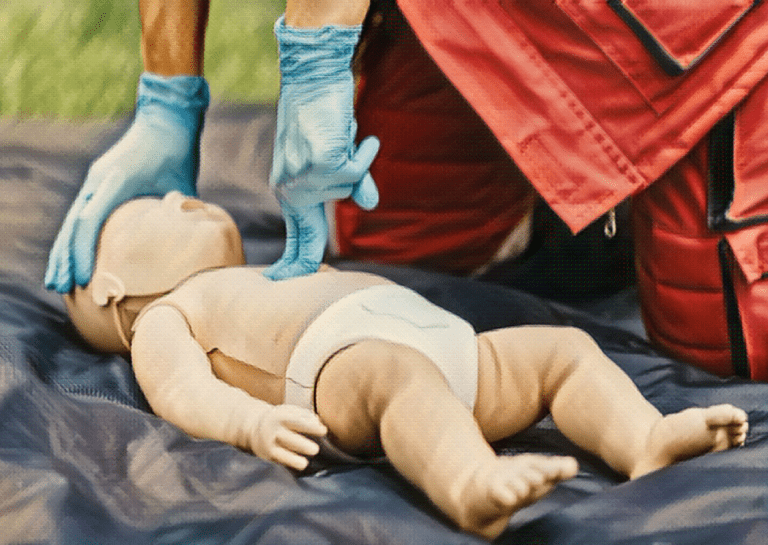Cardiopulmonary Resuscitation (CPR) is a life-saving technique performed on victims of cardiac arrest. Cardiac arrest is when the heart suddenly stops beating and there is an absence of a pulse. CPR can stabilize a patient by restarting the circulation of blood and oxygen throughout the body.
CPR works by combining chest compressions and rescue breathing to prevent organ failure, neurological damage, and death. Early recognition of cardiac arrest and prompt intervention are paramount to the victim’s survival.
There are some important differences between performing CPR on an infant or child and on an adult. This guide will discuss some general need-to-know information on CPR followed by guidelines for approaching child victims of cardiac arrest.
Table of contents
Who can perform CPR?
CPR can be performed by anyone, whether they are a lay bystander or a trained professional. However, the procedure for CPR will depend on the rescuer’s training and skill level.
The American Heart Association recommends that untrained bystanders perform chest compressions only, while those trained in providing advanced life support should incorporate mouth-to-mouth rescue breaths [1].
Chest compressions are the most important element of CPR and should be prioritized over rescue breaths.
Can CPR be used on children?
CPR can and should be used on children who are found unresponsive or are known to have suffered cardiac arrest.
While there are standard guidelines for performing chest compressions on adults, the method and depth of compressions for children depends on their age. It can actually be harmful to use the guidelines intended for adults on children or to use child guidelines on young infants.
When to use CPR
The procedure for initiating CPR in children depends on a number of factors: whether there is one rescuer or multiple, whether the child’s collapse was witnessed or unwitnessed, and whether or not the rescuer is trained in providing advanced life support.
Single rescuer
- If a child is found unresponsive by a single-rescuer and their collapse has not been witnessed, the rescuer should begin CPR straight away (See guidelines for chest compressions and rescue breaths below).
- Although a single rescuer might be unsure of whether to call the emergency services or begin CPR first, it is essential to begin chest compressions as soon as possible. Prioritize performing CPR and call 911 after 2 minutes.
- If the collapse has been witnessed, call the emergency services and immediately find and activate an Automated External Defibrillator (AED). If an AED is unavailable, begin CPR while waiting for help to arrive.
- The rescuer should perform chest compressions at a rate of 100 to 120 per minute. Lay bystanders should perform chest compressions only, while trained rescuers should incorporate rescue breathing at a ratio of 30:2 — 30 compressions to 2 breaths. As for the depth of compressions, use the following guidelines for patients of different ages.
- Infants: 1.5 inches
- Children: 2 inches
- Adolescents: 2.4 inches (per adult recommendations)
- Single rescuers should perform 5 rounds of CPR before activating an AED.
- After 2 minutes of chest compressions, check the child’s pulse and breathing. Spend no more than 10 seconds on this check. If the child remains pulseless, call 911 and proceed to find and activate an AED as soon as possible.
Two or more rescuers
- It is ideal to have two or more rescuers when performing CPR due to the laborious nature of chest compressions. Rescuer fatigue can occur 1 to 2 minutes after beginning CPR, so another rescuer should take over periodically.
- The ratio of compressions to breaths changes when there are two or more rescuers. Rescuers should deliver two ventilations after every 15 compressions, or 15:2 ratio.
- If the child remains pulseless after the first round of compressions, ventilation must be incorporated to replenish the body’s depleted oxygen supplies.
- Multiple rescuers should perform 10 rounds of CPR before activating an AED.
CPR guidelines for use on infants and children
Performing chest compressions
- Infants (under 1 year)— The American Heart Association recommends the two-finger technique for delivering chest compressions on infants. This requires using the index and middle finger and placing them on the infant’s sternum just below the nipples.
If there are two or more rescuers in attendance, the two-thumb encircling hands technique is recommended. This means encircling the infant’s chest with both hands while using the thumbs to perform compressions.
- Children (over 1 year) — Compressions should be performed using either the heel of one hand or both hands. Hands should be placed over the lower portion of the sternum.
Performing rescue breathing
Ventilations should be delivered using mouth-to-mouth, mouth-to-nose, or with a bag and mask. Each rescue breath should be delivered in one second and with just enough air to make the chest visibly rise. Over-ventilation should be avoided as it can lower the patient’s survival rate. If the child exhibits normal breathing but no pulse, rescuers should deliver one breath every two to three seconds (20 to 30 per minute).
References
- Atkins DL, Berger S, Duff JP, et al. Part 11: Pediatric Basic Life Support and Cardiopulmonary Resuscitation Quality: 2015 American Heart Association Guidelines Update for Cardiopulmonary Resuscitation and Emergency Cardiovascular Care. Circulation 2015; 132:S519.
- Kao PC, Chiang WC, Yang CW, et al. What is the correct depth of chest compression for infants and children? A radiological study. Pediatrics 2009; 124:49.
- Topjian AA, Raymond TT, Atkins D, et al. Part 4: Pediatric Basic and Advanced Life Support: 2020 American Heart Association Guidelines for Cardiopulmonary Resuscitation and Emergency Cardiovascular Care. Circulation 2020; 142:S469.
